How do you Connect Lithium Batteries Properly in Series and in Parallel?
2020.09.04
The objective of the parallel connection of lithium batteries is to increase the range and capacity. For this purpose, parallel charging of lithium batteries has different operating characteristics than single-cell lithium batteries, significantly demonstrated in the consistency of the current charging structure and parallel batteries.

You may have known or seen the terms ‘series' and 'parallel' when researching lithium batteries. We also encounter many questions asked by like "What is the difference between series connection and parallel connection separately? Can you connect lithium batteries in series and parallel simultaneously? and similar questions. It may be overwhelming if you're unfamiliar with lithium batteries or batteries in general, so here we'll explain all related information and things that you need to know.

Let's start from the beginning... that maybe your battery bank. The battery bank is the product of integrating two or more batteries for a single device ( i.e., a sailboat). What does linking more than one battery together accomplish? Through connecting the batteries, you either increase the voltage or the amp-hour size and often both, eventually allowing more energy and power.
The first thing to note is that there are two main ways of effectively linking two or more batteries: the first is termed a series connection, and the other is labeled a parallel connection.
● Lithium Battery Connection in Series:
The wiring of the battery in the series is a way of increasing the voltage of the battery. Simply, this connection entails linking two or more batteries together to boost the battery system's voltage while retaining the same amp-hour value. Remember that each battery must have the same voltage and power level in series connections, or you might end up destroying the battery.
To connect the batteries in order, link the positive terminal of one battery to the negative of the other until the appropriate voltage is reached. You have to use a battery that fits the system voltage when charging batteries in order. To prevent imbalance within batteries, we suggest charging each battery individually with a multi-bank adapter.
For example, if you link two of 12 Volt, 10 Ah batteries in sequence, you will establish one battery with 24 Volts and 10 Amp-hours. As most electric motors in kayaks, motorcycles, and scooters operate on 24 volts, this is a popular method of wiring batteries. For example, a number of pro-bass fishermen supported by Dakota Lithium use 36 Volt electrical trolling engines (so they can secretly sneak up on fish). They're wiring 3 of 170 Ah batteries in series to give them about 17 hours of engine trolling time. And that's enough fuel for a week of fishing tours!
● Lithium Battery Connection in Parallel:
Parallel connections entail connecting two or more batteries to maximize the battery bank's amp-hour power, but the voltage remains the same. To link the batteries in Parallel, the positive terminals are connected via a cable, and the negative terminals are connected in with another cable until you achieve the desired power.
A parallel connection is not intended to allow the batteries to control anything above their average voltage output, but rather to extend the length of the power supply. It is important to remember that the improved amp-hour power can take longer charging time while charging batteries linked in Parallel.
For example, if you pair two of 12 V, 10 Ah batteries in Parallel, you will establish a 12 Volt and 20 Amp-hour battery. Though many small electric motors, solar panels, RVs, vessels, and most household appliances operate on 12 volts, this is a standard method of making a battery that can last a very long time. For example, a sailboat pilot who does longer open-water expeditions and wants a long-lasting power device wired 80 of our 12 V, 10 Ac batteries in Parallel to produce an 800 Amp-hour battery. This helps him to operate all his sailboat electronics for up to a month between charges. That's enough time for a single charge to fly from Hawaii to San Francisco.
Now some get confuse whether we can connect lithium batteries in series and parallel at the same time or not. The answer to this is yes; we can. It's possible to pair batteries in series and parallel configuration. This may seem overwhelming, but let me explain. This is a good way to increase the voltage output and the Amp / Hour ratings together. But to achieve this, you need four batteries.
If you already have two sets of batteries wired in Parallel, you can link them together to form a series connection. Don't get confused now. Remember, power flows in a parallel connexion much as it is in a single battery. It's not going to recognize the difference. As a consequence, you can connect two parallel links in a sequence like two batteries. To do this, just one cable is required to make a bridge from a positive terminal from one parallel bank to a negative terminal from another parallel bank.
In fact, you can connect as many batteries as you like. However, when you start building a convoluted mess of batteries and wires, it can be very complicated, and it can be risky too. Keep in mind the requirements for your application. Also, always use batteries with the same capacities. Avoid mixing and matching battery sizes if possible.
Do remember to be safe, and keenly optimize your connections. If it works, make a sketch of your battery banks before you begin to connect them.
Have more questions? Comment below, we'll clear all of your confusion to keep things safe and sound. All the best.
More Articles
Copyright © Fooyoh.com All rights reserved.